![]()
![]()
![]()
Use LEFT and RIGHT arrow keys to navigate between flashcards;
Use UP and DOWN arrow keys to flip the card;
H to show hint;
A reads text to speech;
35 Cards in this Set
- Front
- Back
|
Review:
How does plasma insulin and glucagon change during and after meals? |

|
|
|
1. Glucose can be used by all _________, BUT |
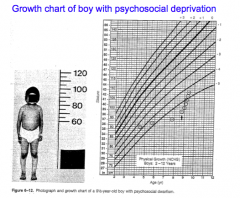
1. Glucose can be used by all tissues, BUT |
|
|
Muscle is about ________ of body mass and at rest, uses about _________of O2 consumed; much more with use. So affecting muscle metabolism has a big effect. --In exercise, muscle _________ also is used; when depleted: it fails to work |
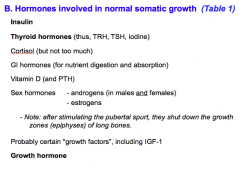
Muscle is about 50% of body mass and at rest, uses about 30% of O2 consumed; much more with use. So affecting muscle metabolism has a big effect. --In exercise, muscle glycogen also is used; when depleted: it fails to work |
|
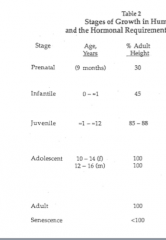
What are the body's objectives for during and after a meal?
1) Fill _________stores (from carbos) 2) Don't spill much ________ in urine 3) Utilize ingested __________ for energy 4) Package _________: carbos & fats as _________ [in AT (adipose tissue)] AAs as ___________ |
![1) Fill glycogen stores (from carbos)
2) Don't spill much glucose in urine
3) Utilize ingested carbos & fat for energy
4) Package excess:
carbos & fats as TAG [in AT (adipose tissue)]
AAs as protein](https://images.cram.com/images/upload-flashcards/07/47/94/7074794_m.png)
1) Fill glycogen stores (from carbos) 2) Don't spill much glucose in urine 3) Utilize ingested carbos & fat for energy 4) Package excess: carbos & fats as TAG [in AT (adipose tissue)] AAs as protein |
|
|
What is the glucose-fatty acid cycle?
Draw using the following: Fatty acids TG FFA CO2 Glucose-6-P GLucose
Adipocyte Blood Myocyte |
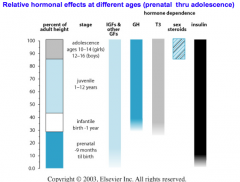
|
|
|
Between meals (post-absorptive phase)
Objectives
1) Keep _________ ~ constant for CNS, etc. 2) _____ Glucose utilization (except CNS, etc) 3) Keep some _______ reserves (for “quick use") 4) Burn ______ for energy (FA, KB) 5) Utilize "sparable" _________ (& glycerol, lactate, etc.) for gluconeogenesis |

Between meals: Post-absorptive phase
Objectives
1) Keep glucose ~ constant for CNS, etc. 2) Glucose utilization (except CNS, etc) 3) Keep some glycogen reserves (for “quick use") 4) Burn fats for energy (FA, KB) 5) Utilize "sparable" proteins ( AAs) (& glycerol, lactate, etc.) for gluconeogenesis |
|
|
What are the two origins of fuel? Where do they go? What are the three components of fuel consumption? |
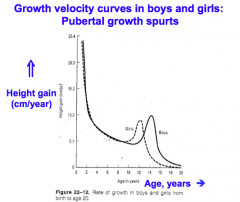
|
|
|
Major Processes _____ glucose uptake & utlization ______lipogenesis _____fat stores _____PS |

|
|
|
Fill in the time courses:
Short acting vs. Long acting
Onset of actions (rapid, delayed) Duration (brief, prolonged)
Examples of each
Primary mechanisms:
|

|
|
|
During fasting:
How does glucose change days 1-5? What about insulin? Glucagon?
Cortisol levels?
Sympathetic activity levels?
GH levels?
T3 levels?
Think about the effects of each on metabolism. |
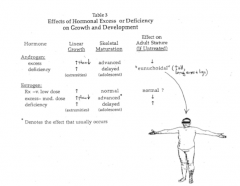
|
|
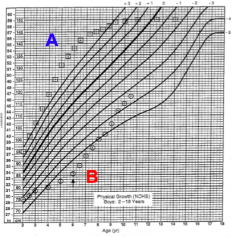
What are the three hormones that do no change between feeding and fasting? |
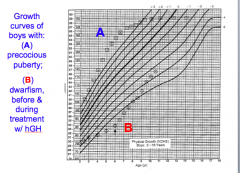
Cortisol, GH, T3 |
|
|
How does glucagon, E and NE, and insulin change from "during and after a meal" to " between meals" |
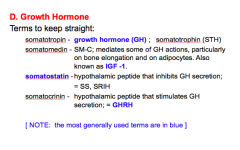
|
|
|
Which hormones promote glucose production in the liver?
Which inhibits glucose production in the liver?
Which hormones inhibit glucose consumption in muscle and adipose tissue?
Which hormone promotes glucose consumption (muscle and adipose tissue)? |
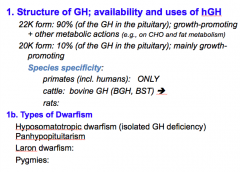
|
|
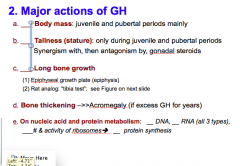
Glucagon, epinephrine, and cortisol act ___________ on plasma glucose concentration. |
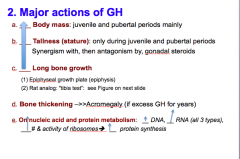
Synergistically. |
|
|
Draw the pathways for hormonal effects on FFA production.
Insulin, glucose, a-glycerol, fatty acids, triglyceride, hormone sensitive lipase, protein kinase A, cyclic AMP, ATP, insulin, NE and E, cortisol, GH |
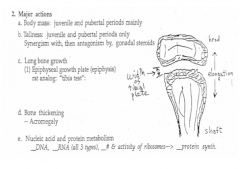
|
|
|
What is the time course for lipolysis stimulated by catecholamines as compared to GH (which is faster and is much more potent)? |

|
|
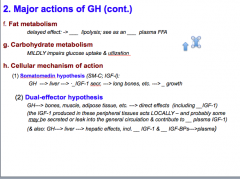
Glucocorticoids promote ______ by complimentary mechanisms:
A. In the LIVER: |
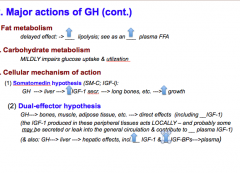
|
|
|
Enzymes Altered by Glucagon:
A. Via __ cAMP and __ protein kinase A: 1. __ phosphorylase activity 2. __ glycogen synthetase activity 3. __ formation of F-2,6-BP: __ PFK activity (__ glycolysis) __ F-1,6-BPase activity (__ gluconeogenesis) 4. __ PK activity (___PEP è pyr ... & __ AcCoA) 5. __ AcCoA carboxylase activity (__ AcCoA __ malonyl CoA ... __ LCFA synth. and ...__ LCFA b-oxidation, since mal-GoA inhibits CPT-1, and thus inhibits FA b-oxidation)
B. Uncertain mechanisms 1. __ PEP carboxykinase synthesis 2. sl. __ Pyruvate carboxylase |

|
|
|
What happens to plasma glucose during exercise? FFA? Muscle glycogen? in terms of contribution to oxygen uptake |
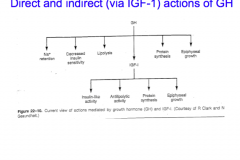
|
|
|
How does insulin, E, NE, glucagon, cortisol, GH change during exercise? |
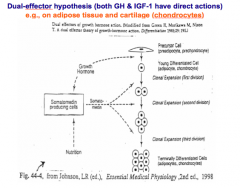
|
|
|
What happens when you give exogenous insulin?
Which three hormones then increase around 70?
Which hormone increases around 60?
When do you start to get symptoms of hypoglycemia?
What does the liver do around 50?
At what level does cognition start to decrease? |
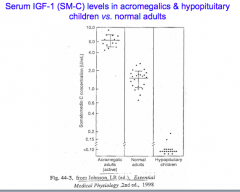
Your own insulin secretion shuts off. |
|
|
What are the effects of IGF-1 on GH Rx on growth velocity? |
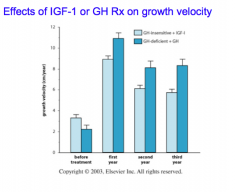
|
|
|
What are the effects of GH medication? Retention of what elements? |
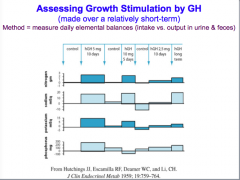
|
|
|
What is the effect of T3 on growth hormone? |
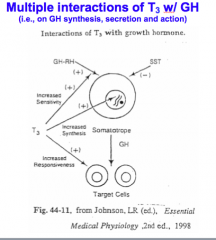
Increases number and size Secretes more Increase responsiveness of target cells to growth hormone |
|
|
What is the effect of GCs on GH? |
Decrease growth hormone Cortisone in higher amounts => decrease in growth rate. |
|
|
What is needed for GH to stimulate growth? |
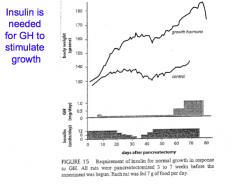
Insulin
Reduction in insulin => decreased growth rate even with GH |
|
|
What would happen to growth rate if you have hyperthyroidism? |
Decrease to to hyper metabolic effects => decreased calories available for growth |
|
|
What is the major time to secrete growth hormone? |
Secretory pattern = ultraridian (episodic)
Major secretion at night associated with deep sleep |
|
|
Which sleep stages if GH secretion associated with?
What are cortisol levels during this time? |
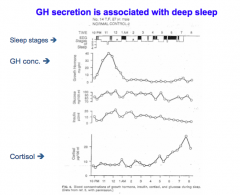
Stages III and IV |
|
|
What age range has the highest levels of GH? |
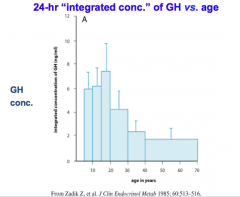
|
|
|
What are range has the highest levels of IGH-1? |
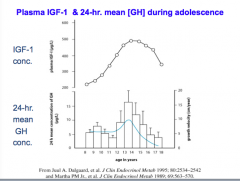
|
|
|
Which hormones also increase GH secretion? |
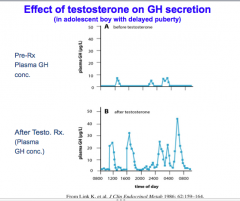
Sex |
|
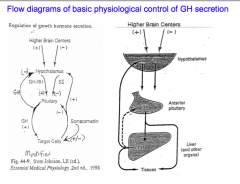
|
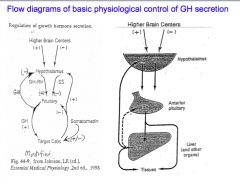
|
|
|
Does insulin-induced hypoglycemia stimulate GH secretion? |
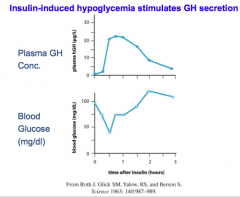
|
|
|
What might be a more useful measure of a person's GH secretory status? |
IGF-1 levels |

